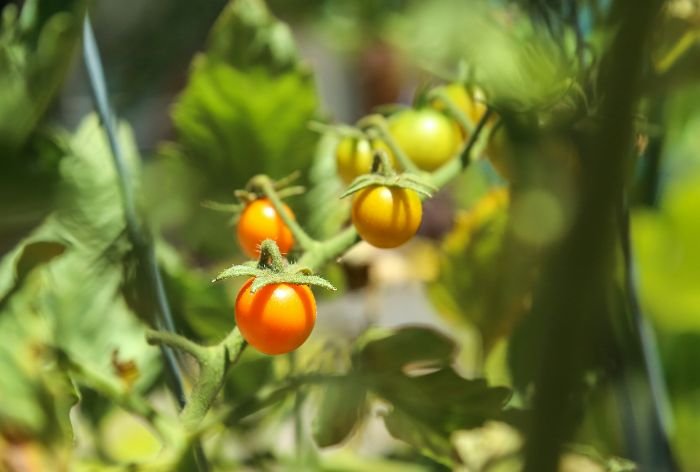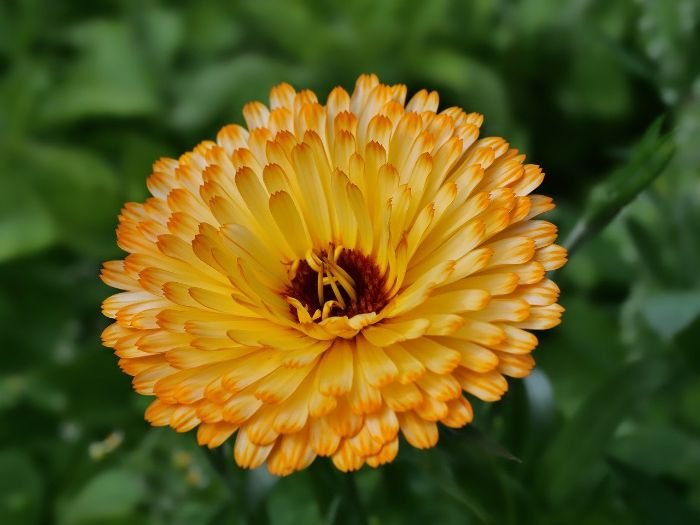Gardening often leads us to look for natural ways to stop pests. Surprisingly, the best solution might already be in our gardens. It’s a simple but hidden find.
Have you thought about using marigolds and tomatoes to fight pests? They make a powerful team without needing chemicals or costly tricks. These plants have a special bond that fights off invaders naturally.
This article will dive into companion planting. We’ll show you why marigolds and tomatoes are a great pair. You will learn the science behind how they scare pests away.
But is this idea just a story, or does it really work? Let’s uncover the truth about how marigolds and tomatoes fight off pests naturally.
Key Takeaways:
- Marigolds and tomatoes can be used together in companion planting for natural pest control.
- Their combination has proven benefits in repelling common garden pests.
- Marigolds contain natural compounds that repel pests and improve soil health.
- Tomatoes benefit from the presence of marigolds, leading to healthier plants.
- Companion planting offers an eco-friendly and cost-effective alternative to chemical pesticides.
Table of Contents
About Companion Planting
Companion planting is a smart way to plant. It helps each plant grow better, fight off pests, and stay healthy. Gardeners have been doing this for many years. It helps create a happy plant family in the garden.
What is Companion Planting?
Companion planting means some plants help each other grow. For example, some plants keep bad bugs away from others. And some make the soil better for their neighbors. Choosing the right friends for your plants makes a garden that stays strong on its own.
The Specific Benefits of Marigolds and Tomatoes
Marigolds and tomatoes are great friends in the garden. Marigolds look pretty and smell strong. They do a lot to protect tomato plants too.

Marigolds keep pests away with their smell. Bugs like aphids and whiteflies don’t like it. So, they stay away from the tomatoes. This means you don’t need as many chemicals to keep your plants safe.
Marigolds also bring good bugs to the garden. Ladybugs and lacewings come to eat the bad bugs. This makes a healthy balance in the garden. The tomatoes are less likely to get eaten by pests.
Marigolds even stop weeds from growing around tomatoes. They do this by putting out chemicals that stop weed seeds from sprouting. This keeps the area clear for the tomatoes to get the sun and food they need.
Together, marigolds and tomatoes make a great team. They fight off pests, bring in helpful bugs, and keep the garden weed-free. This makes for happy, healthy tomato plants.
The Science Behind Marigolds and Pest Control
Marigolds are known for keeping pests away naturally. They help the soil too. We will talk about how they do this.
Natural Compounds in Marigolds That Repel Pests
Marigolds make substances that pests don’t like. One of these is pyrethrin. It kills bugs like aphids, whiteflies, and leafhoppers by messing with their nerves.
Pyrethrin keeps these pests from eating your plants. By planting marigolds, you protect your garden crops. It’s all thanks to pyrethrin.
There’s also thioamides in marigolds. They stop nematodes, tiny worms that hurt plant roots. Nematodes are repelled by marigolds. This way, your garden stays healthy.
How Marigolds Affect Soil Health and Pest Deterrence
Marigolds don’t just push pests away. They help the soil, too. These flowers give off substances that make the soil better.
Such substances help good soil bugs. These bugs help make the soil good for plants. So, your garden thrives with marigolds around.
Marigolds also mess up pests’ life cycles. Nematodes like to eat the plant food marigolds release. But then, they can’t move. This stops them from hurting your plants.
The whole garden wins with marigolds. They make a place where pests don’t want to be. Your garden becomes a balanced, healthy home for plants.
Pests Targeted by Marigolds
Marigolds are great at keeping pests away, which is why they’re perfect near tomatoes. When you plant marigolds next to tomatoes, you shield them from many pests. This happens all naturally.
Common Tomato Pests and Their Impact
Tomatoes often fall prey to many annoying bugs. These pests can harm the plants and lower the amount of tomatoes you get. Here’s a list of some of these pests:
- Aphids – These tiny bugs suck the sap out of tomato plants, making the leaves curl and turn yellow. They can also spread diseases to the plants.
- Whiteflies – Like aphids, whiteflies drink the tomato sap but leave a sticky substance behind. This attracts a black fungus and makes it hard for the plant to make food.
- Tobacco Hornworms – These big, green caterpillars eat the tomato plant’s leaves, stems, and fruit. They cause a lot of damage if not stopped.
- Tomato Fruitworms – These worms like to eat the tomato fruit, making holes and ruining parts of the tomato that you can eat.
- Spider Mites – Very small spider mites like hot, dry places. They suck on the tomato leaves, turning them yellow, spotted, and then they fall off.
These pests don’t just weaken the tomato plants. They can also spread diseases and hurt the plants’ health, leading to fewer tomatoes.
How Marigolds Repel Nematodes, Aphids, and Other Pests
Marigolds naturally keep pests away because of unique chemicals they produce. These chemicals are in the roots, flowers, and leaves and bug-proof them.
Marigolds particularly hate nematodes, the tiny worms that mess with tomato roots. Marigolds put out stuff that makes nematodes stay away. This protects the tomato plants’ roots from harm.
Besides stopping nematodes, marigolds keep away other bugs like aphids, whiteflies, and hornworms. The smell and chemicals from marigolds mix up these pests’ senses. They can’t find or eat the tomato plants, so they head elsewhere.
Adding marigolds to your tomato garden can act like a shield against these pests. This means you don’t need as many bug sprays, which is good for the garden and the planet.

Planting Marigolds with Tomatoes
Planting marigolds with tomatoes is great for your garden. It’s not just pretty; marigolds fight off bugs. This keeps your plants healthy. Here’s how to do it well:
Best Practices for Companion Planting
- Mixing Plants – Place marigolds and tomatoes all around your garden. Don’t plant them together in big groups. This way, bugs won’t find a clear path to your tomatoes.
- When to Plant – Start marigold seeds indoors a bit before the last frost. Plant them outside after the frost danger is gone. Do the same with your tomato seedlings, around the same time or a bit later.
- Give Them Space – Space marigolds and tomatoes 12-18 inches apart. This lets them get the air and sun they need.
- Choosing the Right Types – Pick the right kinds of marigolds and tomatoes. French and African marigolds are good for repelling pests. For tomatoes, ‘Celebrity’ and ‘Roma’ types work well with marigolds.
Layout Ideas for Effective Pest Control
Want your garden to really fight off pests? Try these layout ideas:
- Border Planting – Plant marigolds around the edges of your tomato beds. This keeps bugs away from your tomatoes.
- Interplanting Rows – Put rows of marigolds and tomatoes back and forth. It looks nice and keeps the pest battle going strong across the garden.
- Mixed Planting – Mix marigolds right among your tomato plants. This can make it hard for pests to know where to attack.
Choose what works for your garden. Trying different methods can lead to a bountiful and bug-free tomato season.
Benefits Beyond Pest Control
Marigolds do more than repel pests and keep tomato plants safe. They make soil better and bring good bugs. This helps your garden a lot.
Enhancing Soil Health and Nutrient Cycling
Marigolds make the soil healthier. Their roots stop bad bugs, like nematodes, from hurting tomatoes. Placing them near your tomatoes acts as a natural shield.
Marigolds have deep roots that break up hard soil. This lets water and nutrients move better. They also add food to the soil as they break down, making it richer.
Marigolds bring in helpful creatures like earthworms. These friends make nutrients available to plants easily. So, your tomatoes grow better with marigolds around.
Attracting Beneficial Insects with Marigolds
Marigolds don’t just keep away pests. They invite good insects too. For instance, ladybugs eat aphids, helping your garden stay balanced.
Marigolds’ pretty and scented flowers draw bees and butterflies. These bugs help tomatoes grow by pollinating them. So, using marigolds helps with pests and pollination, leading to more tomatoes.
Selecting the Right Marigold Varieties
Choosing the right marigold types is key for the health and beauty of your garden. Each kind offers unique benefits for your tomato plants. By knowing about French and African marigolds, you can decide best for your garden.
French Marigolds vs. African Marigolds
French marigolds and African marigolds are great for keeping bugs away, but they differ in some ways. French marigolds are smaller with a strong scent, while African marigolds are bigger and have a softer smell.

French marigolds grow to about 6 to 12 inches and have small, bright flowers. Their strong smell fights off bugs like aphids and nematodes. They are good for pots and borders.
African marigolds can grow up to 3 feet. They show off large, colorful flowers and keep pests away. These are great for brightening up beds and borders.
Recommendations for Specific Varieties
Think about the pests in your area and what looks good when picking marigold types. Here are some that work well with tomatoes:
- French Marigold Varieties:
- Disco Series
- Lemon Gem
- Scarlet Sophie
- African Marigold Varieties:
- Crackerjack Mix
- Deep Orange
- Gold Coin
These marigolds are good at keeping pests off your tomatoes. They also make the garden look beautiful. Choose colors that go well with your tomato plants.
Picking the right marigold types can help control pests and make your tomato garden a lovely sight.
Care and Maintenance of Marigolds and Tomatoes
Watering, Feeding, and Pruning Tips
Taking care of marigolds and tomatoes is key to their health and growth. Here are some important tips:
- Watering – Marigolds like their soil to be dry. But, tomatoes need a lot of water. So, water marigolds less, letting the soil dry out some. Tomatoes should be watered often, especially when it’s hot and dry. Moisture diseases can be avoided if you water at the base of the plants.
- Feeding – To help them grow strong and produce lots of flowers or fruit, fertilize both kinds of plants. Marigolds should get a slow-release fertilizer every four to six weeks. For tomatoes, use a good tomato fertilizer as directed. Be careful not to use too much, or you might have more leaves and less fruit.
- Pruning – Keeping both plants in good shape helps avoid disease. For marigolds, take out the old flowers to make new ones keep coming. Also, cut back stems that are getting too long or bunched up. With tomatoes, pick off the little shoots that grow between the stem and branches. This helps put their energy into making fruit. Pull off any yellow or sick leaves to stop sickness from spreading.
Seasonal Care for Continued Pest Control
For a healthy and pest-free garden all through the year, do these:
- Spring – Before you plant marigolds and tomatoes, work the soil and get rid of weeds. Watch for bugs and use natural ways to keep them in check, like bringing in helpful insects.
- Summer – In summer, keep a close watch for pests. Look out for bugs that bother tomatoes, like aphids or caterpillars. Make sure your tomatoes have enough shade when it’s really hot to avoid sun damage.
- Fall – As the season end approaches, keep looking for pests and diseases. Clean up and throw away any sick plant parts to stop pests from staying. Consider planting cover crops to help the soil and keep it from washing away over winter.
- Winter – If it gets cold where you are, cover your plants or move them inside to protect them from frost. Winter is a good time to plan for the future garden and choose which new plants to try.
Common Challenges and Solutions
Planting marigolds with tomatoes helps keep pests away and makes them grow better. But there are some issues to understand and solve. This makes sure your plants do well together.
Dealing with Potential Issues in Companion Planting
Marigolds and tomatoes both need sun, water, and nutrients. This could make them fight for these things. To avoid this, make sure they have enough space. This lets each plant get what it needs.
There’s also a risk of too many bugs on the tomatoes. Even though marigolds usually keep pests away, some might still bother the tomatoes. Checking your plants often can stop pests early. Plus, planting things that attract good bugs can help keep the bad bugs in check.
Ensuring Healthy Growth for Both Plants
Giving your plants the right care helps them grow well. They need regular water, especially if it’s dry. Using natural fertilizers also helps them get the nutrients they need.
Don’t forget to prune. Cutting off bad leaves stops diseases and makes the air around the plants better. It also helps keep the plants the right size and lets light in.
So, by taking care of your marigold and tomato plants, you can overcome many challenges. With good solutions and care, your garden will thrive. You’ll have beautiful marigolds and tasty tomatoes to enjoy.
Conclusion – Embracing Natural Pest Control
By using companion planting, your garden can stay safe and healthy in a natural way. For example, growing marigolds and tomatoes together is helpful. It fights off pests and boosts the plants’ health and growth.
Marigolds have a special power to keep pests away. They make natural substances that bugs don’t like. This helps in keeping harmful insects away from your tomatoes. Also, having marigolds close by helps the soil stay healthy. This makes it harder for pests to live there.
Choosing where and what to plant is key in companion planting. Mixing marigolds with tomatoes in the garden or putting them around the edges brings the most good. Also, pick marigold types that are the best size and color for fighting pests.
Using natural ways to stop pests is good for your plants and the planet. Planting marigolds with tomatoes is a smart move. It brings benefits to both and is a step towards a cleaner, greener garden.
FAQ
What is companion planting?
Companion planting is growing plants near each other to help both plants. It helps with growth and stops some bugs. This makes gardens healthier.
What are the specific benefits of planting marigolds with tomatoes?
Planting marigolds with tomatoes helps both. Marigolds keep harmful bugs away from tomatoes. They also bring good bugs that help tomatoes grow.
What natural compounds in marigolds repel pests?
Marigolds have thiophenes that keep away bugs like nematodes and aphids. These chemicals stop pests from bothering other plants.
How do marigolds affect soil health and pest deterrence?
Marigolds put out chemicals that stop some pests and diseases. This can make the soil healthier and safer for plants.
What are the common tomato pests and how do marigolds repel them?
Aphids, whiteflies, and nematodes are common tomato pests. Marigolds keep these pests away naturally. This helps the area around tomatoes stay bug-free.
What are the best practices for planting marigolds with tomatoes?
Plant both marigolds and tomatoes all around. Make sure there is space between them. Change where you plant them every year to fight pests.
What layout ideas can be effective for pest control?
Planting marigolds in rows or circles around tomatoes can help. This layout acts like a barrier to pests. It uses marigolds’ pest-repellent power to the fullest.
Do you have any recommendations for specific marigold varieties?
For planting with tomatoes, try types like ‘Nema-Gone’ or ‘Tangerine’. These are good for keeping pests away. But, any marigold can help with pests a little.










